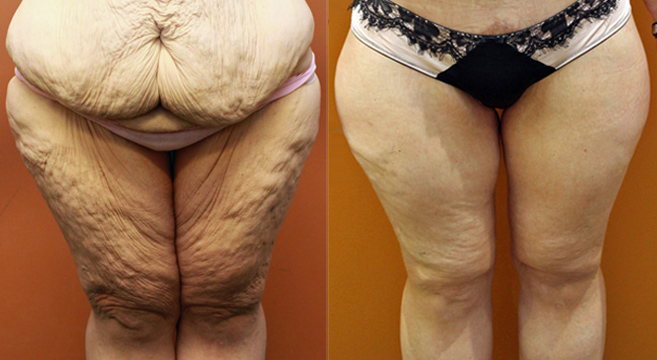What to Expect During Recovery after Thigh Lift
Thigh lift surgery involves removing excess skin and fat from the thighs to provide a more toned and firm appearance. It can be a procedure recommended for those who have lost significant weight. However, like any surgery, thigh lift involves a recovery process which you need to understand and prepare for.
Before undergoing a thigh lift, it is essential to have a clear understanding of the procedure, what it entails, the risks involved, and the expected results. This way, you will be better equipped to handle the recovery period and achieve an optimal outcome. Remember, information is power, and the more you know about what to expect, the smoother your recovery after thigh lift will be.
Dr Lim’s 2024 Abdominoplasty Guide

The decision to get a thigh lift surgery should not be taken lightly. It requires a commitment to a healthier lifestyle, a willingness to endure a healing process, and an understanding of the realistic outcomes of the procedure. It’s important to have an open and honest discussion with your plastic surgeon about your expectations and concerns.
With many years of experience, Sydney Specialist Plastic Surgeon Dr Jake Lim is committed to providing personalised care, prioritising patient safety, and ensuring a high standard of surgical practice. His approach to plastic surgery involves understanding each patient’s individual needs and goals, and designing a treatment plan that can deliver an optimal outcome.

How Is the Recovery after Thighplasty?
The recovery journey following a Thighplasty, or thigh lift, is an intricate process that involves your body’s immune system actively repairing the tissues affected by the surgery. This wound healing process consists of three primary stages: inflammation, proliferation, and maturation.
In the initial stage of inflammation, your body responds to the surgical trauma by activating its immune response, clearing out the damaged and dead cells from the surgical area. This is a critical process that helps set the stage for the healing to follow. Swelling and mild discomfort, common symptoms during this period, are natural signs of your body working to heal itself.
The proliferation phase follows inflammation. In this phase, your body starts the task of rebuilding the damaged tissue. New cells form and multiply, and fresh blood vessels develop in the surgical area to facilitate this regrowth. It’s during this stage that you might notice a gradual reduction in the post-operative swelling and start to see the first signs of your new contours.
The final stage of the recovery process, maturation, involves the strengthening and remodelling of the newly formed tissue. This phase can extend over several weeks or even months. It is during this stage that your surgical results will solidify, and the full effect of the Thighplasty becomes evident.
Grasping these stages of healing can help patients understand why it’s so important to rest adequately, maintain good nutrition, and adhere to the post-operative instructions provided by Dr Lim. Recovery is a process that requires patience. Rushing through recovery or failing to follow post-operative care guidelines can potentially lead to complications and undermine the aesthetic results of your Thighplasty. It’s essential to give your body the time and care it needs to heal successfully and deliver an optimal outcome from your surgery.
What to Expect During Recovery after Thigh Lift
Recovery is a significant part of your plastic surgery experience, and knowing what to expect can help ease any anxiety or fear you may have. After your thigh lift surgery, you will likely experience some discomfort, swelling, and bruising in the treated area. These are normal signs of healing and should gradually diminish over time.
You will need to take some time off work to rest and recover. In the initial days following your surgery, you should focus on resting as much as possible to allow your body to heal. You may also need assistance with day-to-day activities, so it’s advisable to arrange for help ahead of time.
Dr Lim will provide specific instructions for wound care, medications to take, signs of complications to watch out for, and when to schedule follow-up appointments. Following these instructions diligently will greatly enhance your recovery after thigh lift and reduce the risk of complications.
Thigh Lift Surgery Recovery Timeline
Every individual’s recovery after thigh lift is unique as it depends on several factors such as age, health status, and adherence to post-operative instructions. However, a general thigh lift surgery recovery timeline can provide a rough idea of what to expect.
In the first week post-surgery, you may experience discomfort, swelling, and bruising. By the second week, these symptoms should start to lessen. By the fourth to sixth week, you should notice a significant improvement and may be able to resume light activities. Full recovery can take several months as your body continues to heal and adjust to the changes.
Remember, this timeline is just a general guide. Dr Lim is the best person to provide an accurate recovery timeline based on your individual circumstances.
Tips for Optimal Recovery after Thigh Lift
Preparing for your recovery after thigh lift can greatly affect your overall healing process. Here are some tips to ensure an optimal recovery.
Ensure you have a comfortable and relaxing environment for your recovery period. Stock up on essentials so that you don’t need to worry about shopping or running errands post-surgery. Stay hydrated and maintain a balanced diet rich in proteins and vitamins to support your body’s healing process.
Listen to your body and rest when needed. Avoid strenuous activities and follow Dr Lim’s instructions on when you can resume normal activities. Finally, keep a positive mindset. Remember, recovery is a process, and every day you are one step closer to your goal.

Common Challenges during Thigh Lift Surgery Recovery
Like any surgical procedure, recovery after thigh lift can present some challenges. You may experience discomfort, swelling, and bruising, which can be managed with medications prescribed by Dr Lim. You might also feel tired or low energy due to the healing process.
Emotionally, you may feel anxious or impatient about the healing process and the visible results. It’s essential to know that these feelings are normal and understandable. Remember to be patient with your body and give it the time it needs to heal.
How to Speed Up Your Recovery After Thigh Lift
While you can’t rush your body’s natural healing process, there are things you can do to support and potentially speed up your recovery after thigh lift. Staying hydrated, eating a nutritious diet, and getting plenty of rest can all contribute to a faster recovery.
Avoid smoking and alcohol as they can slow down your healing process. Follow Dr Lim’s instructions about wound care and medications meticulously. Regular, gentle movement can also help speed up recovery by promoting blood flow and reducing the risk of blood clots.
What to Look for in a Thigh Lift Surgeon
When considering a thigh lift, it’s important to choose a qualified and experienced surgeon. Look for a specialist plastic surgeon with substantial experience in thigh lift procedures. Ask about their success rate, complication rate, and whether they have before and after photos that you can review.
A good plastic surgeon will take the time to understand your goals, explain the procedure, and discuss the risks and benefits. They will also provide clear pre and post-operative instructions and be available to address any concerns or questions you may have during your recovery after thigh lift.
What to Avoid During Recovery after Thigh Lift
During your recovery after thigh lift, there are a few things you should avoid to ensure a smooth healing process. Avoid intense activities and heavy lifting until Dr Lim gives you the go-ahead. This is to prevent any strain on the healing tissues and to avoid complications.
Avoid smoking and drinking alcohol as they can impede your body’s ability to heal. Also, avoid wearing tight clothing that can put pressure on your incision sites. Instead, opt for loose, comfortable clothing that is easy to put on and take off.
While the recovery after thigh lift can be challenging, knowing what to expect during the process can make it more manageable.
FAQs about Recovery after Thigh Lift
Can I walk after thigh lift surgery?
- You can walk after a thigh lift surgery, but it may not be immediately after the procedure. Each patient is unique, and the recovery time can differ. Patients are encouraged to start only limited light walking as soon as they feel able—often within the first day or two post-operation—to promote blood circulation and reduce the risk of complications like blood clots. Make sure to follow the specific guidelines given by Dr Lim, as over-exertion can hinder the healing process.
What is thigh lift recovery like?
- Thigh lift recovery is a process that takes a few weeks. In the first week or so, you might experience pain, swelling, and bruising. These symptoms can be managed with prescribed medication. By the second week, you should notice these symptoms subsiding significantly. You may have drains to remove excess fluid from the incision site, which are usually removed after one to two weeks. Most patients can return to non-strenuous work within 2 weeks and regular physical activity after 6 weeks, but this can vary based on the extent of the surgery and your personal healing process.
How should I sit after thigh lift surgery?
- When sitting after a thigh lift surgery, it’s crucial to avoid direct pressure on the incision sites to allow for optimal healing. This often means you will be advised to either recline or lie down rather than sit upright for the first few days post-surgery. If you need to sit, try to do so without leaning or putting pressure on the thighs. Using cushions or special seating arrangements can also help to alleviate pressure. Always follow Dr Lim’s specific instructions on sitting positions post-surgery.
What to wear after thigh lift surgery?
- After thigh lift surgery, it’s recommended to wear loose, comfortable clothing that doesn’t put pressure on the incision sites. In most cases, Dr Lim may also provide or recommend a compression garment. This garment, which is like a snug pair of shorts, can help to minimise swelling, support your new contours, and aid in the healing process. It is usually worn for several weeks after the surgery, but the exact duration will be determined by your plastic surgeon.
How are the thigh lift scars?
- Thigh lift scars are a natural outcome of the surgery, but their visibility and extent depend on the type of thigh lift you undergo, your body’s healing capacity, and the skill of your surgeon. Dr Lim aims to place the incisions in less noticeable locations, like the groin fold or the inner thigh. Over time, these scars fade to thin white lines and become less noticeable. However, they won’t disappear completely. Certain treatments like silicone sheets, scar creams, and laser treatments can help to further minimise the appearance of scars.
Further Reading about Body Procedures with Dr Lim
- Read Dr Lim’s Medial Thigh Lipectomy Surgery Page
- Read Dr Lim’s Body Procedures after Weight Loss Page
- Read Dr Lim’s Abdominoplasty Surgery Page
- Read Dr Lim’s Upper Body Lift Surgery Page
- Read Dr Lim’s Lower Body Lift Surgery Page
- Read Dr Lim’s Blog about Recovery after Lipsuction
- Read Dr Lim’s Blog about Recovery After Lower Body Lift
- Read Dr Lim’s Blog about Typical Emotions Experienced After Plastic Surgery
- Read Dr Lim’s Blog about Healthy Food and Supplements During The Post-Operative Period
Medical References about Thigh Lift and Recovery after Surgery
- Thigh Lift (Thighplasty): Types, Surgery, Recovery & Scars
- Thigh Lift (Thighplasty) – Plastic Surgery Center
- Thigh Lift Recovery




